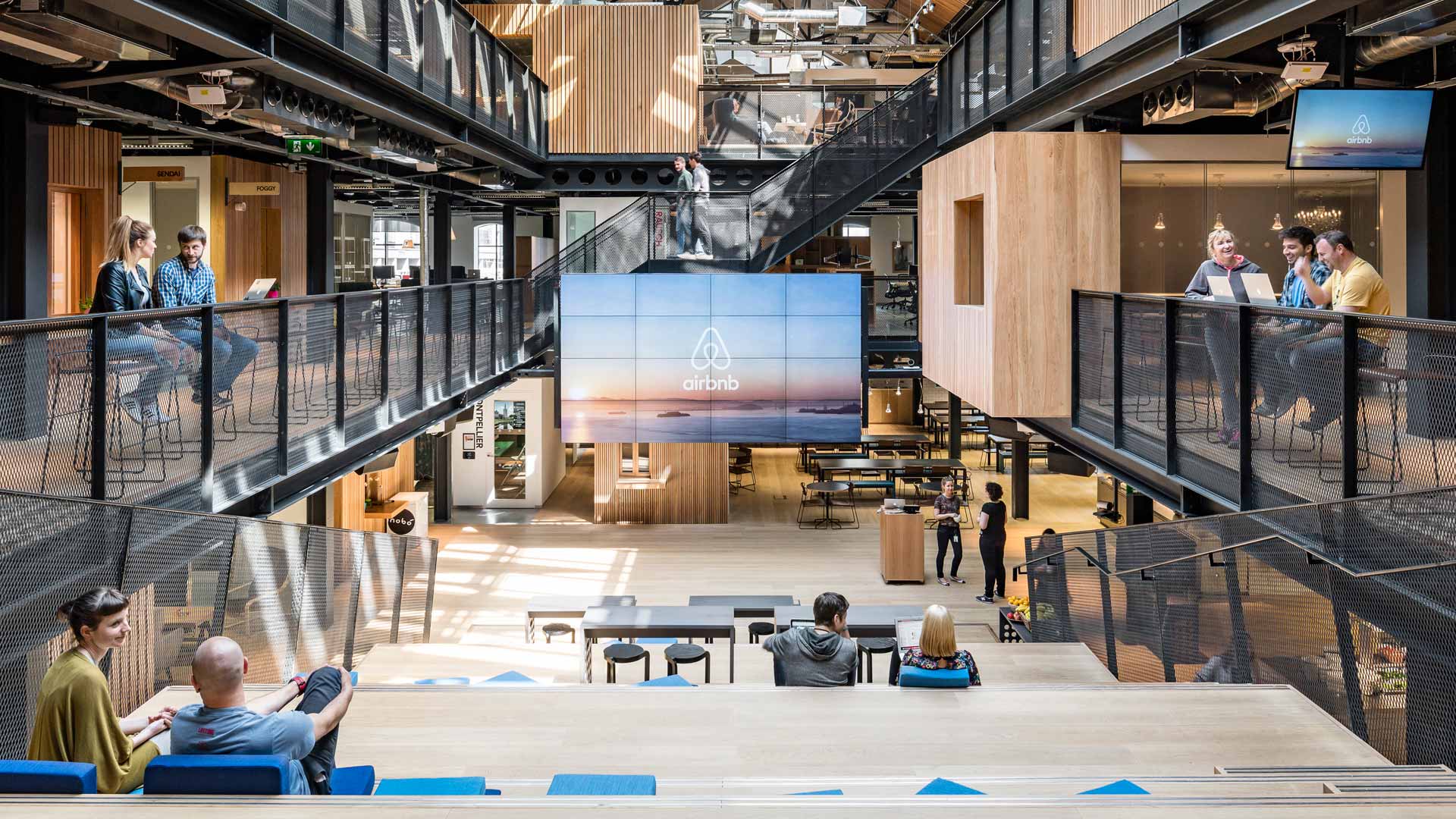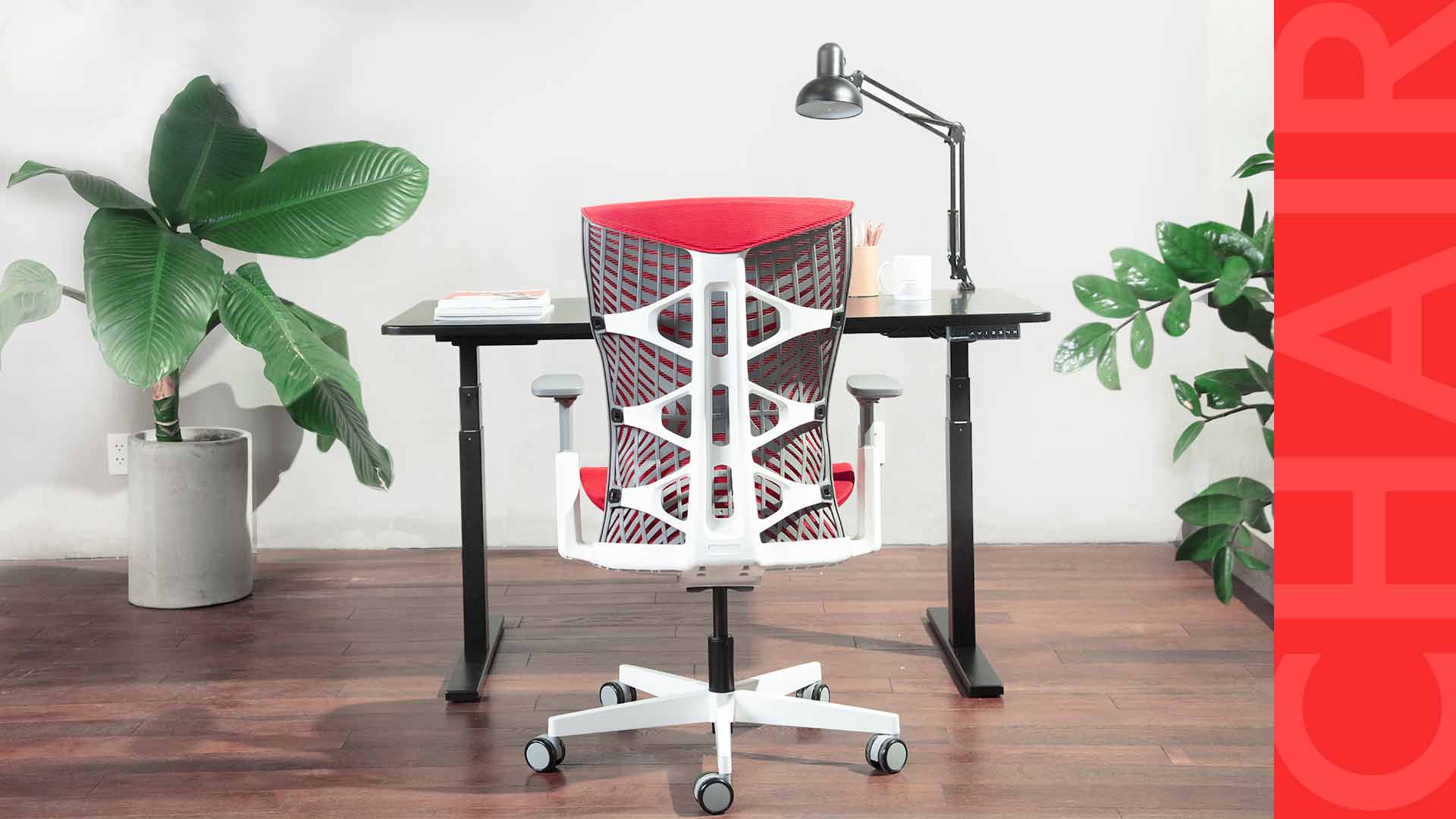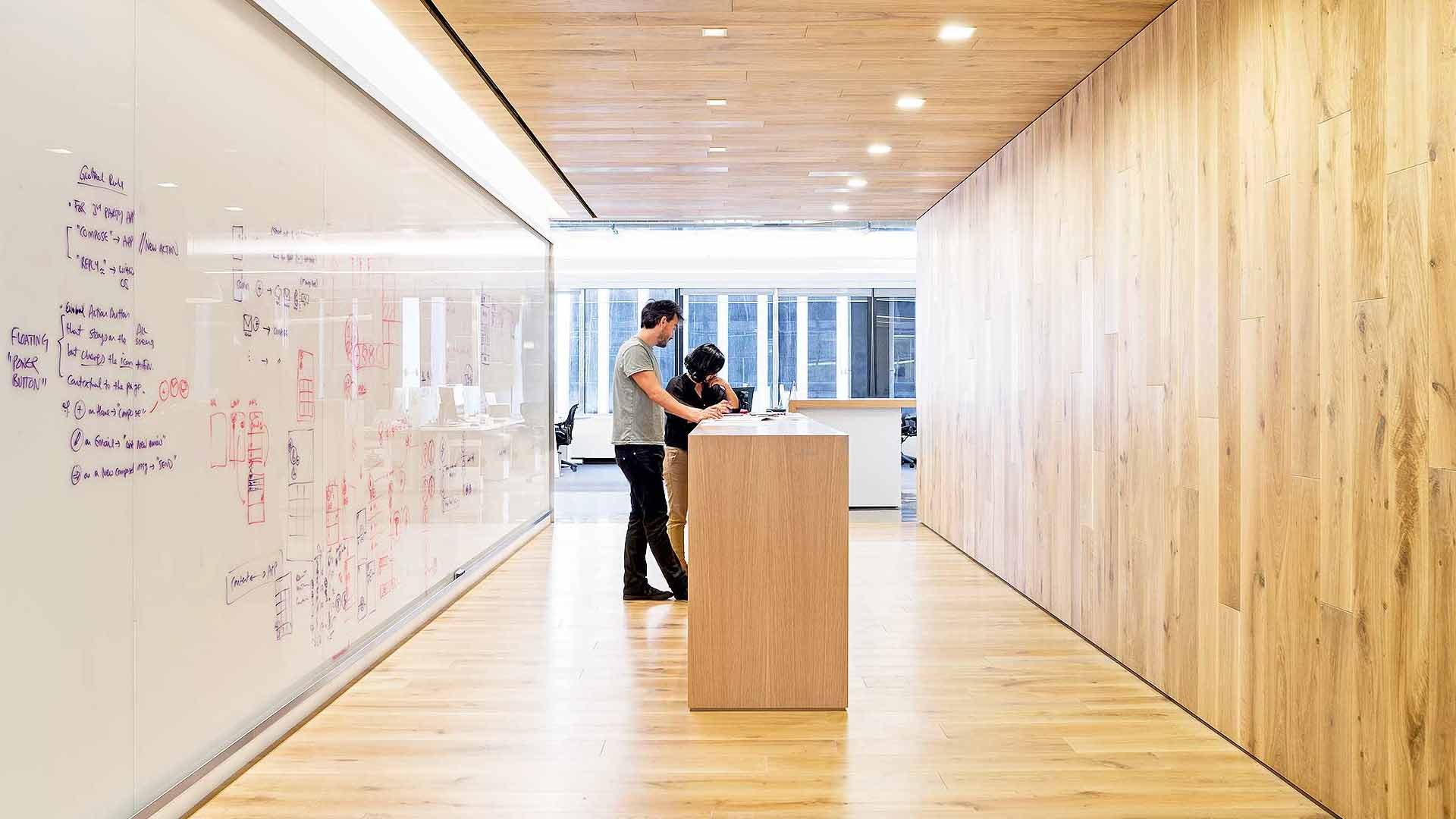/https://storage.googleapis.com/s3-autonomous-upgrade-3/static/upload/images/new_post/office-design-guide-to-create-the-vibe-of-a-startup-413-1583382595008.jpg)
How To Plan Your Office Design To Create That Startup Vibe
Your office design can make or break your company. With startups offering fun, creative office spaces full of natural light, flexible workspaces and foosball tables, the time is now to revamp your space to attract and retain top talent.
But before you go spending a bunch of money on a complete office design makeover, it's important to understand exactly why you're doing it and what your goals are. You need to lay a proper foundation before you rebuild your house.
This article is our 7-step guide to helping you do just that, with each of these steps explained in detail further down on this page.
- Step 1: Define your office design identity as a company
- Step 2: What are your design ideas and WHY are they important for achieving your goals?
- Step 3: Repeat step 2, again and again, to flush out all of your design ideas
- Step 4: Learn from the best office design
- Step 5: Working within financial and spatial boundaries
- Step 6: Ask your employees what they think about the new office design!
- Step 7: Be willing to try and willing to change
Something to think about
Imagine getting to work every morning and stepping off the elevator into the office filled with yellow-tinted ceiling lights and a sea of grey cubicles, those tiny little cage-like spaces, rigidly defining your assigned workspace, clumped together stretching as far as the eye can see. How does it make you feel? Happy? Inspired? Or do you want to get back on the elevator and get out of the building as fast as you possibly can?
Unfortunately, too many people for far too long didn’t need to imagine this setting; they lived it. Some still live it. But times have changed, prompting more companies to step out of their comfort zones and explore the idea of what it means to have a “startup vibe” at your office, even if you’re not a startup.

Today, you might step off an elevator (or walk up some stairs) into an office and be greeted with open space, beautiful wood beams, rows of electric standing desks and ergonomic chairs, meeting rooms with windows and glass walls welcoming in tons of natural light, game rooms filled with laughter and chatter, and most importantly, employees that actually look happy to be at work!
With global brands such as Google, Apple, Instagram, and Airbnb leading the way, a generation of entrepreneurs with big ideas are following, determined to provide a different work experience than Peter Gibbons and his colleagues struggled through in the classic 90s film, Office Space.
Having “a case of the Mondays” is the last thing modern companies want their employees to experience.
Your office is your new business card.
The office is no longer just a physical space where employees dutifully show up to do their job. It’s become a calling card, an opportunity to show the world who you are and to attract top talent.
If you’re not viewing your office environment this way, you risk being left behind. Why would a top developer, creative or executive choose to step off that first elevator into a depressing, grey land of cubicles when they now have so many more interesting office environments to choose from?
With increasing numbers of people saying that salary isn’t the most important factor in deciding where to work, the “Golden Handcuffs” are no longer the trap they used to be for many job seekers, especially Millennials.
Golden Handcuffs definition:
“When you’re tethered to a job you absolutely hate but feel like you can’t leave it because of the money, perks or benefits it provides.”
Providing a creative, innovative work environment shows you’re a company that is forward-thinking and understands the new job market. If you care enough to invest in creating an awesome office with thoughtful workspaces, odds are you’ll approach your employees with the same level of care and open-mindedness, and talented job seekers will make that connection.
So how do you take what might not be a very exciting workspace and turn it into something that inspires your employees and attracts new ones?
Well, that depends on your budget, how much space you have, and above all what type of company you are and what image you want to present to the world. But no matter which category you fall under, you can certainly find the “startup vibe” to fit your workspace.
Let’s begin...
STEP 1: Define your identity as a company
You must know yourself before you can improve yourself. The same goes for a company.
If you’re a tech company that encourages a lot of collaboration between employees, then you’ll probably want to create a work environment that’s completely different than if you’re a financial company that requires a lot of phone calls discussing private client information.
Redesigning your office space provides an opportunity to introduce a new direction for your business. Creating a space that enhances what you already do is important, but a redesign can also be a catalyst for what you want your company to grow into.
So, who are you?
And perhaps more importantly, who do you want to be?
Answer those questions first, then proceed…
STEP 2: What are your ideas and why are they important for achieving your goals?
Now that you’ve defined who you are as a company, what does your dream workspace look like? What type of environment and experience are you striving for? Write down what you want to achieve with your office space design and why. Then why is key. Remember, any company can go buy a foosball table and throw it in their lunchroom, but if they don’t understand why they’re doing that and how it helps their company, then the point is lost.
Here’s an example to illustrate the importance of knowing why.
Company A:
Idea: Let’s buy a foosball table for the office!
Why?
Goal: Umm, because we watched the TV show “Friends” a lot when we were growing up and foosball looks like fun, and we want our office to be a fun place to work.
Company B:
Idea: Let’s buy a foosball table for the office!
Why?
Goal: Because our company is full of really creative, innovative thinkers and studies have shown that games are a great way to both relax the mind while also keeping it sharp, thus allowing our employees to have some fun while still being engaged, which will then propel them to return to work and be even more productive. It also increases camaraderie within our staff.
Boom! Now that’s a company that knows what’s up. It’s created a space that offers value to the employee, both personally and professionally, as well as a return on investment for the business.
STEP 3: Repeat step 2, again and again, to flush out all of your ideas
Idea: We’re going to provide free healthy snacks on a daily basis and invest in a quiet space for employees to meditate or to simply wind down and recharge.
Why?
Goal: We want to attract and keep top talent and research shows that young professionals in our industry value their physical and mental health more than ever before. We want them to know that we prioritize that, so they can feel comfortable and supported when they’re at work.

Idea: Get rid of all our cubicles and closed meeting rooms to create a more open workspace.
Why?
Goal: We see all these startups using this design and employees seem to really like it, especially younger employees, and that’s who we’re trying to attract.
Problem: Our company requires many of our employees to be on the phone much of the day discussing private information with our clients. Is an open workspace really the best plan for us?
It’s important to maintain a critical view of your vision. It might look cool and work great for another company and be a disaster for your company. Keeping your business identity in front of mind throughout the process is critical.
Idea: Let’s go with a very minimalist design that incorporates a lot of glass and natural light.
Why?
Goal: Our company’s brand is all about a fresh, clean image, so we want our office to represent that image with a bright, natural-looking space. We want our physical space to be on brand, just as our products are.
As you list your ideas and stay focused on why they’re important, your vision will become more clear and you’ll get a real sense of what will work best for your company.
Airbnb’s head office in San Francisco is a great example of a company knowing their brand to a tee and designing their office to match it. The company chose to design their meeting rooms and other common areas to replicate actual Airbnb listings from around the world, giving their employees a direct, physical connection to their work.

Kelly Robinson, designer of the Airbnb office as well as other modern workspaces such as Soundcloud and Headspace, expressed a crucial point about office design especially as it relates to tech companies.
“An internet company exists in the cloud and often a team’s workplace is the first and only opportunity they have to turn their product into something physical and tangible.”
Recognizing a disconnect between their brand, their employees and their workspace, and understanding the importance of those connections, Airbnb transformed their office into an awesome place to work.
STEP 4: Learn from the best
You know what they say: imitation is the sincerest form of flattery.
This doesn’t mean you can straight up copy another company and get the same results, but you can certainly learn from the motivations and goals of a successful company’s office design, then customize it to fit your business.
Let’s take a look at one of the best examples of a major office overhaul and what it did for the company.
Way back in 2004, when Google was just a company and not yet a common verb, they set out to flip the whole idea of an office on its head with the creation of the now-famous Googleplex. The plan was to transition from the traditional office layout into more of a campus environment, offering a mix of creative workspaces as well as both indoor and outdoor spaces where employees could eat, relax and play.
As Googleplex architect, Clive Wilkinson puts it:
“A typical campus environment offers the concept of self-containment, so within the immediate area, all of your basic work/life needs can be met and the possibility of casual encounters with fellow ‘students’ for collaboration or recreation is possible anytime during the day or night.”

“...At the university level, the opportunities are to support the goals of personal education, with a focus on each individual’s interests, but when these interests become common to a community, the results can be very powerful.”
And as Google and its influence on the world stage continued to grow, their office model opened the eyes of many and inspired companies across many industries to rethink their office designs. It not only seemed to inspire greater ideas and productivity from current employees, it worked as a magnet to attract the best and brightest talent from around the world. They wanted to work for Google so that they could work at Google.
“Google’s goal wasn't just to design a new office space.
The goal was to create a community.”
You don’t need a two-million-square-foot space called Googleplex in order to create a community. You can do it anywhere, under almost any budget, with the right plan.
STEP 5: Working within financial and spatial boundaries
Colors count
A simple paint job can do wonders for the workspace, at minimal cost. Studying the effects of different color schemes on mood shows that color hacking your office can transform it into invoking an entirely fresh range of emotions.
 Adding artwork
Adding artwork
Google’s New York City headquarters features hallways painted to look like city streets and rooms to mimic apartments and other urban settings. Again, you don’t need to be Google to pull off a similar feat. Think about the products your company offers and your location. Maybe you can feature works from local artists or commission one to paint a mural that presents a scene connecting your company with local neighborhoods. Facebook did something similar to this in its earlier days, and eventually, it turned into an artist-in-residence program. How cool would that be to have at your office? And imagine the positive attention it could garner.
Let the light shine in
If your office is on the smaller side, you can put a greater emphasis on using natural light and green space to brighten the workspace, with studies showing it can have a huge impact on the work environment. Simply changing your blinds to let in more light wouldn’t cost much and could offer a great return on your investment.
 Go green
Go green
Much like color and natural light, adding plants to the office can have a direct impact on reducing stress and improving your mood. Better yet, the simple act of watering a plant could be a nice mini-break from a challenging assignment. There are also specific plants that can help purify the air in your office.
 Make the most of your space
Make the most of your space
A great way to get creative with a small space, especially in a more collaborative office, is to take full advantage of open wall space. Put up a big whiteboard along one wall to use for meetings or to encourage brainstorming and collaboration. Add a tv screen to another to use for presentations, or, if you’re a production company, for example, use it to show off demos of current projects in development.
 STEP 6: Ask your employees what they think!
STEP 6: Ask your employees what they think!
Now that you’ve spent countless hours thinking about your future office space and game planning how to make it happen, it’s the perfect time to ask for a little employee feedback before making major changes. If it’s a community atmosphere that you’re going for with your new space, and it should be, then it’s only right to ask that community how they feel about it.
Happy employees are productive employees, and maybe what will make them happy isn’t what you thought would. You could also solicit ideas from staff at the very beginning before you even start planning, but doing so with a game plan already in place accomplish two things:
1. It shows employees that their company cares enough to be proactive and invest time into developing a vision towards creating a happier, healthier and more productive work environment.
2. When you approach employees for feedback with ideas already in place, along with why you’re considering each idea, it might inspire them to come up with additional viewpoints that they otherwise would never have considered. Sometimes you need that first idea to spark a second idea, and the second idea is the winner!
Also, from a business perspective, it’s more efficient to make adjustments based on employee feedback to a plan you already have than to start a plan from scratch based on what could be a long list of different ideas going in all sorts of different directions. As the saying goes: you can’t please everybody all the time. You can, however, show them that you care and value their opinion, and that will be appreciated within the community you’re building.
And don’t forget...
Your employees are not robots. They are not all the same, so don’t treat them as if one design will fit all. As best you can, create a workspace that gives your employees options for how they’d like to work. Find the right mix of open collaborative spaces and quiet, secluded ones, with the right balance of playtime in between. And remember that something might look cool and fit your brand well but might not work at all for comfort or productivity! Which leads us to our last step...
STEP 7: Be willing to try and willing to change
This is pretty self-explanatory. Try something. If it doesn’t work, try something else. Creating an awesome, productive, inspiring workspace with a “startup vibe” doesn’t happen overnight. It might take time to find the right mix of ideas that fit your brand while also enhancing the actual work environment. And even when you find that perfect mix, you might learn that it’s still a good idea to continue trying new things. Even the coolest office designs don’t stay cool forever, but if you’re constantly trying new things and listening to your employees then your company and the community it creates will maintain a reputation as a desired workplace for top talent.
Read more...
Why An Open Office Design Might Not Work For You
Why Your Office Space Needs Natural Light
How To Color Hack Your Office Space For Productivity
Why Being Happy At The Office Is Good For Your Business
Subscribe for a 10% discount on your first order.
Sign up for our weekly update and be the first to know about our specials & promotions.
Verbreiten Sie es weiter

/https://storage.googleapis.com/s3-autonomous-upgrade-3/production/ecm/240417/april-10-off-offer-2024-1920x540-CTA.jpg)
/https://storage.googleapis.com/s3-autonomous-upgrade-3/production/ecm/240417/april-10-off-offer-2024-720x1200-CTA.jpg)
/https://storage.googleapis.com/s3-autonomous-upgrade-3/production/ecm/240415/bulk-order-apr-2024-offer-720x1200-CTA-min.jpg)
/https://storage.googleapis.com/s3-autonomous-upgrade-3/production/ecm/240415/pod-offer-apr-2024-720x1200-CTA.jpg)
/https://storage.googleapis.com/s3-autonomous-upgrade-3/static/upload/images/new_post_author/admin-1.png)